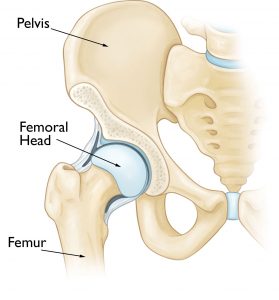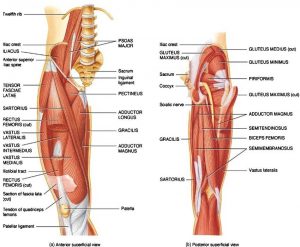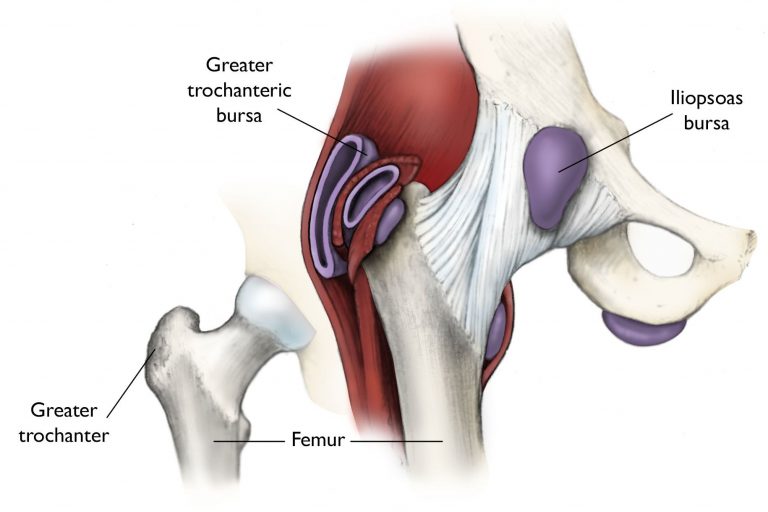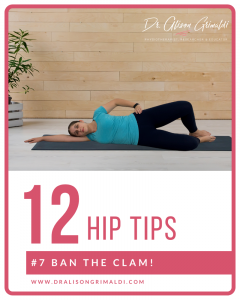Hips are strong and stable joints. They have the capacity to move forward and backward, sideways and rotate. Maintaining adequate mobility around the hips allows you to bend, lift and jump. Weak hips are associated with knee problems. Stiff hips can contribute to pain and problems in our lower back, pelvis and spine.

There are multiple structures around the hip that can cause pain. Hip pain significantly impacts your ability to participate in daily activities and reduces quality of life. The two most common parts of the hip that cause hip pain are
- The Hip Joint itself: Osteoarthritis and the cartilage around it
- The muscles: Gluteal tendons that support the hip

The bones and joints of the hip.

The muscles and tendons of the hip.
What Hip Pain Looks Like
Depending on what is causing the pain (i.e. the muscles or the joint), you will experience different symptoms. It’s not uncommon for there to be a combination of factors (i.e. both the joint and the tendons). In either case, physiotherapy is essential in slowing down and reversing the disease process – even if you end up going under the knife later on.
- Pain sitting, especially crossing your legs. Getting out of low chairs is uncomfortable.
- Pain with steps or stairs – pain may occur at the time, or delayed and be worse the day after
- Pain often worse after deep squats
- Getting in and out of the car is uncomfortable
- Sleep can be interrupted by pain – painful to lay on the sore hip, but also painful when that hip is on top
Common Myths about Hip Pain
- I’ve got a bursa in my hip. So I’m stuck with this hip pain.
Bursas are fluid filled structures that are naturally occurring throughout the body, including the shoulders and knees. When there is excessive pressure on them, the increased friction can cause excess swelling so the bursas actually appear on ultrasound (healthy bursas have very little fluid and are so thin they are hard to see on ultrasound).

So in a nutshell, if a bursa is mentioned on an ultrasound report, it probably means the bursa is irritated. BUT that doesn’t mean it’s THE problem. In fact, pain from the bursa is hard to distinguish from gluteal tendon pain – but they are both treated in the same manner: the goal is to improve the load through all the structures around the hip by releasing what is tight and strengthening what is weak.
2. I’m a middle-aged woman. This is just a natural part of ageing I need to put up with. Perhaps I just need to do less.
It’s true that changes to hormones, including a reduction in oestrogen, does impact collagen formation which is a key component of tendons. So peri menopausal women are at increased risk of tendon issues (strains, ruptures and overuse injuries), including those around the hip. All tendons have the capacity to become irritated and painful if they are loaded improperly or above their capacity for long enough.
But that is not to say we need to put up with tendon pain! Tendons will still respond to appropriate load and exercise at any age. The appropriate exercise program will include consideration of the whole lumbar spine, pelvis and hip movement system.
It can take time, but with consistent practice the tendons can be rehabilitated to be much less painful and to be much stronger to tolerate the walking, running and exercising we want. Hip pain from tendons is common, and can be just as debilitating as pain from osteoarthritis that is treated by going under the knife for a hip replacement. So don’t just put up with it – the longer you take to get onto it, the slower it can be to respond.
3. I’ll just get cortisone – that will fix it. It fixed it last time.
Wait! Stop!
The hip is sore because it has been poorly loaded over time. You need to address the causes or you’ll be back at square one in no time.
Corticosteroid injections into tendons have been repeatedly shown in research studies to delay recovery when compared to a “wait and see” or physiotherapy management approach. Not just for the hips but for all tendons.
Yes, the cortisone injection will provide short term pain relief. But as cortisone achieves pain relief by essentially putting the tendon to sleep, it will delay the tendon’s responsiveness to your exercise program – guaranteed. You will then have to work longer and harder the next time the pain returns. And it will – whether you get a few days, weeks, months or years out of your cortisone injection – you can be sure that it will be back if you haven’t addressed the underlying causes.
The gold standard approach is to avoid cortisone as a first option, completed a two to three month rehabilitation and only turn to cortisone if physiotherapy fails. You’ll thank yourself in the long run.
4. I do my clam exercises and hip stretches so I’m sorted for hip exercises.
You need to stop stretching your sore hip!
Certain popular stretches actually twist or compress the hip tendons against the bone and cause a continuation of the irritation within the muscle cells (I’m looking at you clam exercises!). Tendons hate compression but love being lengthened. Clams and hip stretches can actually be some of the worst for certain types of hip pain.
The key is understanding that the hip is a point where load is transferred up from the foot to the pelvis and trunk. So exercises need to look at the function of the whole hip-pelvis-lumbar spine complex.
An exercise program will be the only way you can load your hip tendons in the right way to cause the necessary structural changes to make the muscle stronger. Injections provide pain relief but the do not get rid of the cause.
Common Problems Around The Hip That We Treat
- Bursitis
- Tendinopathy
- Osteoarthritis
- Labral tears
Common Causes of Hip Pain
- Recent increase in activity (or intensity of activity) over the previous two months – such as running
- Changes to footwear
- Low chairs
- Chronic issues around the low back and pelvis
- Poor core strength and control
Try This for your Hips
- Try sleeping on your back with a pillow under your knees or on your side with a pillow between your knees
- If this fails, try sleeping “a quarter off prone”: on your tummy but toward one side with that knee bent slightly in front of you (i.e. your left side with your right knee bent at the hip and knee and a pillow in front of your belly to keep you from rolling onto your tummy further)
- Stop stretching your sore hip – it could be making it worse
- Try your pelvic floor exercises (if you don’t know how, ask us!)
How We Help
- We run a battery of tests to determine the specific cause of your hip pain to design the right interventions
- We can test your hip muscle length and strength and design an individualised exercise program for you considering your core strength
- We can provide massage and dry needling for pain relief
- We can give you some tips on how to manage and reduce your pain
- We can show you the specific exercises you need to strengthen the muscles around your hip for long term changes
Resources
Grimaldi, A (2017) Tendinopathy – Does corticosteroid injection aid or hinder our rehabilitation process? Accessed 8th October 2021 from https://dralisongrimaldi.com/blog/tendinopathy-does-corticosteroid-injection-aid-or-hinder-our-rehabilitation-process/


